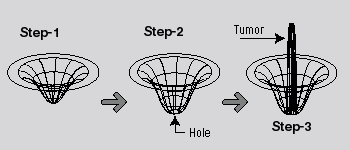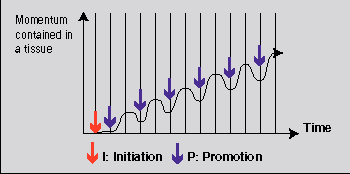 |
 |
|
|
|
 |
V. Tumorigenesis 1/2
Consider theoretically how a tissue causes a tumor. |
|
|
|
|
1. Definition of Tumorigenesis
It can theoretically be concluded that when a tissue causes strong tissue distortion, it causes a tumor at the peak of the tissue distortion. To check this conclusion, let us begin by considering briefly how a tissue causes a tumor. Next, also check the relationship between tumorigenesis and inflammation. Lastly, check the similarities between a tumor and a tropical cyclone in order to recognize more closely tumorigenesis.
2. Outbreak Process of Tumorigenesis
A tissue can theoretically be considered to cause a tumor through three steps. First of all, a tissue causes tissue distortion. Second, when the tissue cannot bear the tensile strength of the tissue distortion, it disconnects, at the peak of the tissue distortion, the continuity in energy flow between cells. Third, the tissue causes an invisible hole there, and also causes new tissue distortion in the invisible hole. This new tissue distortion has the ability of transforming normal cells into tumor cells. That is, by this new tissue distortion, the tissue causes a tumor. The figure below illustrates this process. |
|
|
|

|
|
(Step-1: A tissue causes tissue distortion. Step-2: When the tissue amplifies the tissue distortion, it cuts the connection in energy flow and causes an invisible hole at the peak of the amplified tissue distortion. Step-3: A tissue causes new tissue distortion in the hole: just this new tissue distortion has the ability of transforming the containing cells into tumor cells.) |
|
|
|
3. Relationship between Tumorigenesis and Inflammation
Tumorigenesis can theoretically be considered to need inflammation in order to amplify tissue distortion already caused in a tissue. As explained in the section of "Inflammation," inflammation is a phenomenon: a tissue changes the momentum. In addition, a tissue with tissue distortion amplifies the tissue distortion by changing the momentum. Thus, when a tissue with tissue distortion causes inflammation, it amplifies the tissue distortion by changing the momentum. In short, in the process of tumorigenesis, inflammation is indeed essential for a tissue with tissue distortion to amplify the tissue distortion.
This indication can also be deduced from two-stage carcinogenesis, which is one of the representative experimental carcinogeneses. When a cell is treated with an initiator, it causes genomal instability, followed by causing metabolic distortion. Next, when the cell is also treated with a promoter, it starts amplifying the metabolic distortion by raising the momentum. As a result, the cell causes a tumor. This process reveals that a cell (= a tissue) needs inflammation to cause tumorigenesis. |
|
|
|

|
|
(In the process of Two-Stage Carcinogenesis, every time a tissue already treated with an initiator is also treated with a promoter, it raises the momentum. Why? This is because a promoter indicates a chemical substance having the ability of causing inflammation. This reveals that a tissue needs inflammation to cause tumorigenesis.) |
|
|
|